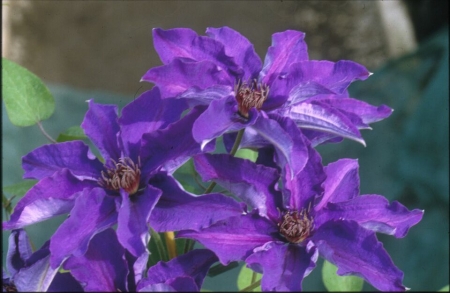Clematis (Clematis Group 2)
×
Color Name: The President
One of the most popular clematis, The President, is a deciduous vine which gets covered with impressively large star-shaped flowers in shades of rich violet-blue. The filaments are white tinged with pinkish to deep reds. A gardener's favorite since its introduction in 1876!
For beautiful colors, extravagance of blooms, and graceful habit, nothing compares with Clematis, the queen of the flowering vines. Whether used on posts or fences, clambering through shrubs and trees, or following wire frames in borders, they will enrich the landscape.
Growing Tips:
LOCATION: Clematis require an area that will have at least 6 hours or more of direct sunlight. The plant, depending on the variety, will grow upright six to twelve feet. However, clematis can only grow as tall as the trellis arbor or support that you have given it. For example, if your trellis is eight feet tall and the clematis you choose grows twelve feet, it would simply hang over and grow down the other side. Clematis roots need shade to prevent the roots from drying out. Mulching the base of the plant not only helps to keep the weeds down but more importantly will keep the moisture in, especially in a hot dry summer.
SOIL PREPARATION: Clematis need a moist, well-drained soil. Prepare your hole at least one foot deep and mix the soil with 50% peat moss or well-rotted manure. Backfill the hole with the amended soil and plant your clematis so the top of the root ball is just below ground level covering the first set of eyes. The plant should be mulched and kept moist, not wet, especially during the first growing season. Fertilize every four weeks during the growing season with a well-balanced liquid fertilizer.
SUPPORT: The main stem of the clematis must have a firm support, otherwise wind damage may occur. As the newly planted clematis produces new growth, it should be carefully trained and tied into position.
PRUNING: In this group all first flowering comes from last season's ripened stems. In early Spring watch for swelling leaf buds beginning to show. Cut all dead material off above these swelling buds. Be sure all growth is tied to trellis at this time. Do not tie too tightly, so growth can begin and not hampered by tying too tight or cracking these stems.
Photo courtesy of Donahue's Greenhouse.
One of the most popular clematis, The President, is a deciduous vine which gets covered with impressively large star-shaped flowers in shades of rich violet-blue. The filaments are white tinged with pinkish to deep reds. A gardener's favorite since its introduction in 1876!
For beautiful colors, extravagance of blooms, and graceful habit, nothing compares with Clematis, the queen of the flowering vines. Whether used on posts or fences, clambering through shrubs and trees, or following wire frames in borders, they will enrich the landscape.
Growing Tips:
LOCATION: Clematis require an area that will have at least 6 hours or more of direct sunlight. The plant, depending on the variety, will grow upright six to twelve feet. However, clematis can only grow as tall as the trellis arbor or support that you have given it. For example, if your trellis is eight feet tall and the clematis you choose grows twelve feet, it would simply hang over and grow down the other side. Clematis roots need shade to prevent the roots from drying out. Mulching the base of the plant not only helps to keep the weeds down but more importantly will keep the moisture in, especially in a hot dry summer.
SOIL PREPARATION: Clematis need a moist, well-drained soil. Prepare your hole at least one foot deep and mix the soil with 50% peat moss or well-rotted manure. Backfill the hole with the amended soil and plant your clematis so the top of the root ball is just below ground level covering the first set of eyes. The plant should be mulched and kept moist, not wet, especially during the first growing season. Fertilize every four weeks during the growing season with a well-balanced liquid fertilizer.
SUPPORT: The main stem of the clematis must have a firm support, otherwise wind damage may occur. As the newly planted clematis produces new growth, it should be carefully trained and tied into position.
PRUNING: In this group all first flowering comes from last season's ripened stems. In early Spring watch for swelling leaf buds beginning to show. Cut all dead material off above these swelling buds. Be sure all growth is tied to trellis at this time. Do not tie too tightly, so growth can begin and not hampered by tying too tight or cracking these stems.
Photo courtesy of Donahue's Greenhouse.
|
Flower Color: Violet Shades Foliage Color: Green Shades
Height: 6 to 10 Feet Spread: 4 to 6 Feet Hardy in Zone: 4, 5 |
Blooms: Spring to Fall
Foliage Season: All Season |
Growth Rate |
Medium
|
Attributes |
Trellis or Wall Extended Bloomer Specimen Plant Landscapes
|







